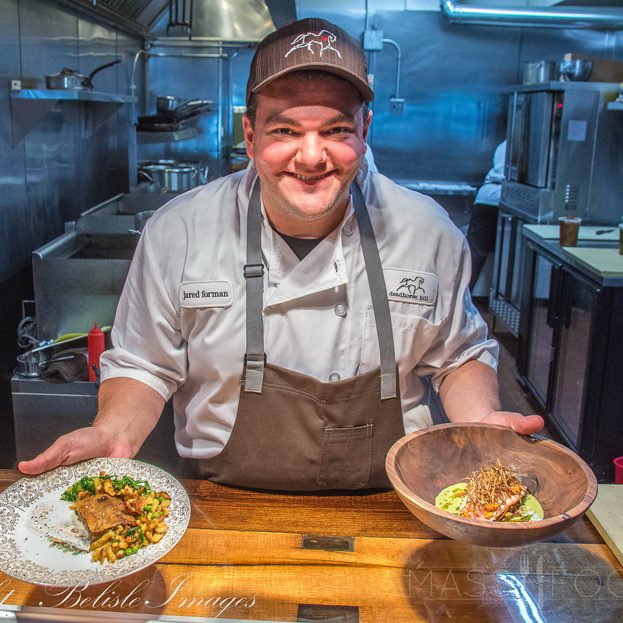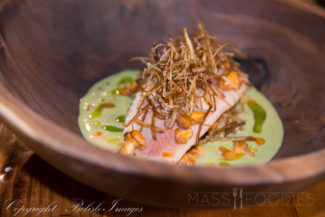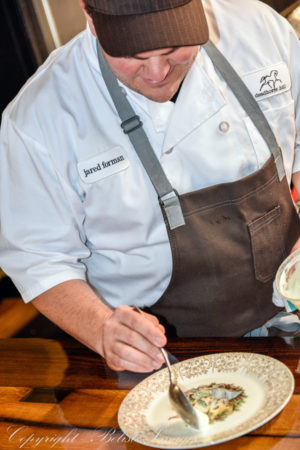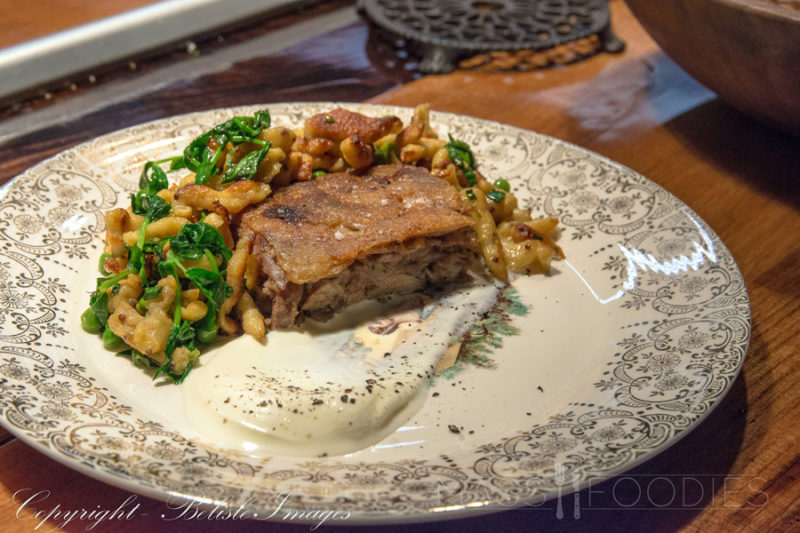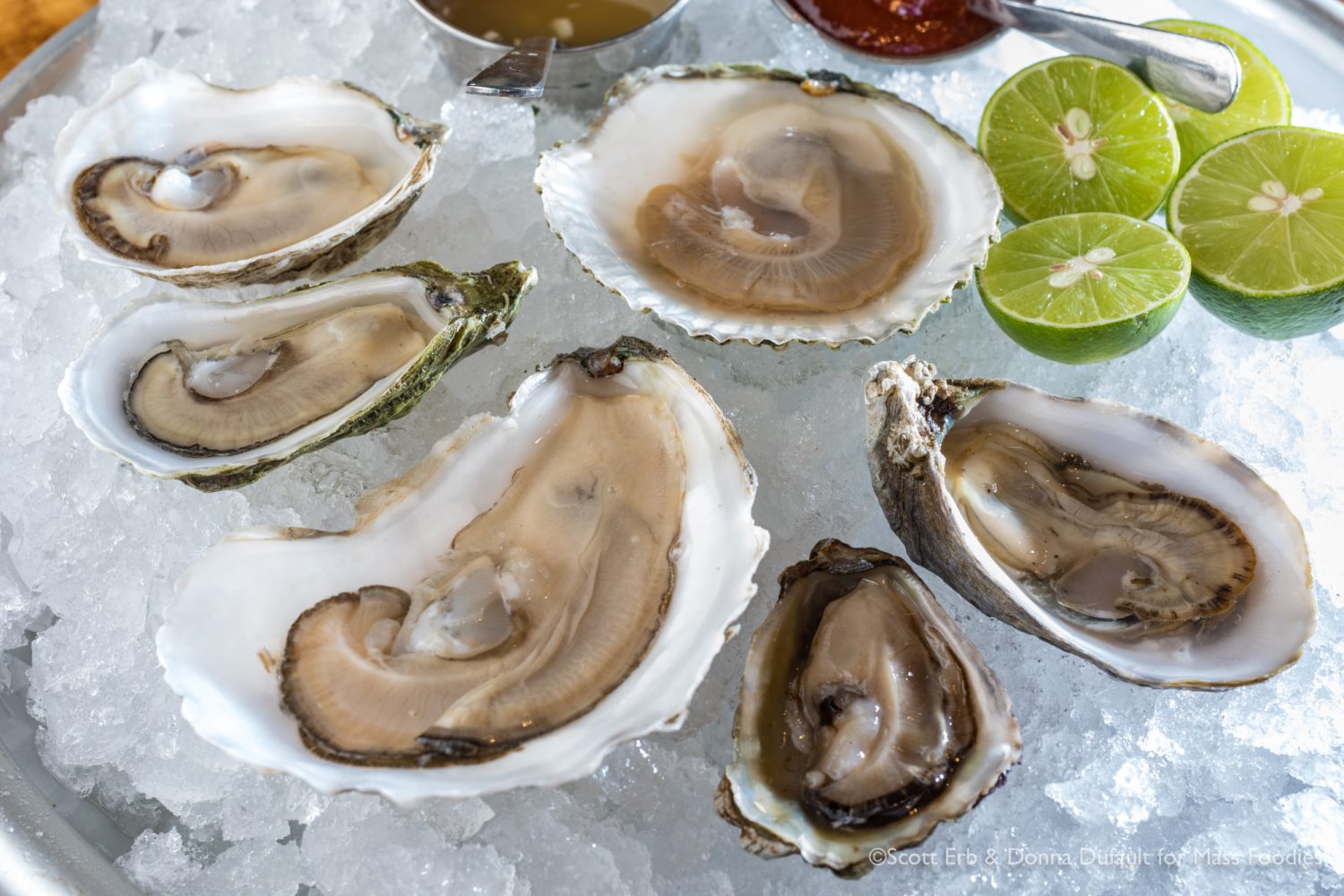
When I was 13, I lost myself in the buttery warm layers of a warm apple tart from Poilâne Bakery in Paris walking up the Rue du Cherche-Midi. I was so captivated by it, I smashed headfirst into a black iron lamp post. (I saved the tart.)
Something similar happened when I first spotted the raw bar at simjang, the new bunsik-style American-Korean contemporary restaurant from the team behind deadhorse hill. Walking into the restaurant, the allure of the glass case filled with oysters, clams, fish, a Dungeness crab, and incredible tiny scallops pulled me left, away from the host stand, and straight into the edge of the actual bar.
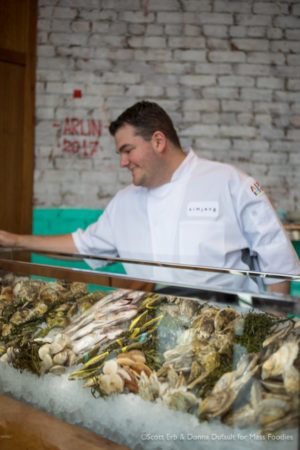
Simjang is Korean for heart and with its raw bar the restaurant is clearly wearing its heart on its sleeve. That raw bar may be just several feet of oysters and other bivalve mollusks and fish but its display is exciting and enticing – a heady mixture of love, passion, and taste. Especially those oysters. Eight varieties of different sizes and species the days I visited, each calling to me with their disparate flavors the way no other spot in town does.
Now before you think my heart analogy is anatomically north of why those oysters have such appeal, the notion that oysters are an aphrodisiac is scientifically unproven. The idea has been around for millennia but there’s nothing conclusive. But at the risk of sounding like I am perpetuating the power of fake news: science be damned. Oysters may be a placebo for desire, but as George Costanza said on Seinfeld, “It’s not a lie, if you believe it.”
Executive chef and co-owner Jared Forman understands. In one context, he called oysters “sexy.” But that was just one context of many. Forman is delighted to do a deep dive into his experience and knowledge of the shallow waters that hold those oyster beds. His tour around the half-dozen oysters I tasted revealed a chef intimately connected to what he serves.
Forman starts with two oysters from the Damariscotta River in Maine. The Maine coast “where the ocean meets the forest” down to Massachusetts captivates Forman, whose definition of a beach was New York City’s Coney Island, which hasn’t been home to oysters since the 19th century. He is particularly rapt by Glidden Points, which look like an oyster that walked (yes, they have a foot) out of central casting. Bottom planted without cages and hand-harvested by divers, they sink into the oxygenated silt and “live in that beautiful muck and do their oyster thing.” With a self-effacing grin, Forman calls them “a fat kid’s oysters” – given their size they shouldn’t be as perfect as they are, but these are meaty, super salty, and perfect. (Case in point, when simjang had some giant Oregon oysters that would be decidedly undelicious raw, they were cooked on the wood-fired grill and sliced.)
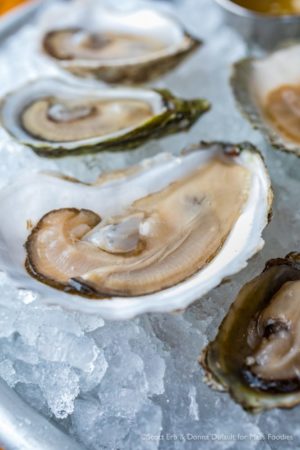
The other Maine oyster on offer during my visit was a Belon. Belons are the legendary European flat oyster of Brittany and true Belons come only from the Belon River there. But Maine Belons seem an equally fine version. Despite their growing proximity, these look and taste nothing like the Glidden Points, which are eastern or Virginica oysters. Belons are a different species entirely and are easily identified in the case where they are wrapped in rubber bands to preserve their freshness and moisture as they lack the ability to keep themselves closed out of water. Like the Glidden Points, Forman notes, these wild Belons are not a beginner’s oyster: “They are super coppery and interesting, but I wouldn’t recommend a half-dozen unless you know what you’re getting into.”
For those who need a gateway oyster, Forman heads south to Massachusetts and Island Creek Oysters – but not the company’s amazing namesake from Duxbury. These are Beach Points, which the company gets from Barnstable. “They are the perfect beginner oyster,” says Forman. “Delicious and easy to love. Nice and salty and crisp. These are for anyone but especially those who come in and want to try oysters but never had one before. The name even sounds approachable.”

The final Virginica or eastern oyster on the plate is a Puffer Petite from Wellfleet Massachusetts. The greenish shell signals its more vegetal flavor but as Forman notes, “It still has that easy brininess.” That brininess is in perfect contrast to the sweetness of two West Coast oysters, the first of which has its origins in Asia and is grown in Williapa Bay, Washington: the Shigoku. Redolent of cucumber and melon, Forman calls them the “ultimate expression of a West Coast oyster,” their sweetness coming from the fact they are a lot less salty than their eastern brethren. These Shigokus are also defined by deep cups which Forman explains comes from the tumbling the oysters like rocks to break off the edges and force them to grow down, not out, which makes for a “real chewy oyster experience.”
Finally, there’s the only oyster indigenous to the West Coast of the United States: the Olympia from south Puget Sound. They are tiny compared to the Gliddens and Belons but buyer beware: these too are not for beginners. “They pack the biggest punch in terms of flavor in the entire case,” Forman says. “They have an appealingly tinny metallic quality to them.”
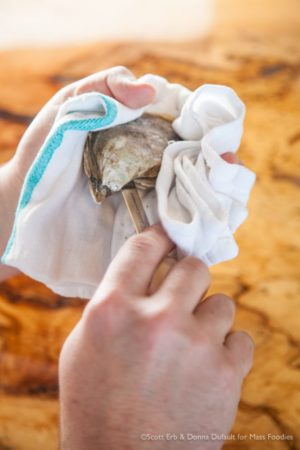
At simjang, the plate of oysters comes with key limes not lemon – tasty and because as Forman notes, “they’re just so darn cute.” For an additional Korean twist, a fish sauce mignonette and a cocktail sauce spiked with gochujang, the legendary Korean red chili paste based condiment come on the side. Enjoy it all with a bubbly glass of Alice, the Osé Rose Brut Vino Spumante, or Medusa’s “Jang,” made exclusively for simjang.
Forman’s Korean connection to oysters dates back to when he worked for Korean-American chef David Chang at Momofuku. (For a look at the Korean raw and cooked seafood tradition, check out the recent Olympic eating story in the New York Times.) Forman had helped prepare Thomas Keller’s famed “oysters and pearls” dish at Per Se, but the passion and personal connection came from working with Chang. Inspired, Forman set off to know oysters the way Bo Jackson knows sports. (Jackson is one of two players, along with Massachusetts native Howie Long, from Forman’s beloved Oakland Raiders who adorn the simjang walls.). He explored flavors of different oysters, studied their history in America and the world, researched their environmental benefits, befriended farmers who grew them, and tried out different knives to shuck them. (He prefers a smaller New Haven style oyster knife from Dexter Russell in Massachusetts.)
Like many chefs, Forman prides himself on the connections he has with the farmers who provide the oysters and everything on display in the raw bar like littleneck (and soon Manilla) clams. But he gets kinda misty-eyed when we get to those stunning small scallops. Their size says “bay” but they are actually baby Atlantic sea scallops, which are. . . illegal to harvest wild.
Executive chef Jared Forman shows us a quick trick in shucking.
Boasting the region’s finest raw bar, simjang brings in an exotic mix of oysters, including the only oyster indigenous to the West Coast of the United States: the Olympia from south Puget Sound. Executive chef and co-owner Jared Forman shows us a quick trick in shucking.
Posted by Mass Foodies on Tuesday, March 13, 2018
But before you go calling the food police, Forman explains that they are actually legally farmed by lobstermen – something until recently he had never seen before. When they pull traps, there are always baby scallops clinging to the ropes. Instead of letting them just die on the boat, the lobstermen Forman works with “grab the tiny guys just like they were an oyster seed, put them in oyster bags, and drop them down into deep water so they are in their natural environment. When they are big enough, they pull the bags up and introduce some back into the environment because they can survive and sell the rest to us as a farm-raised crop. So we are not illegally harvesting but we are actually promoting healthy ecosystems.”
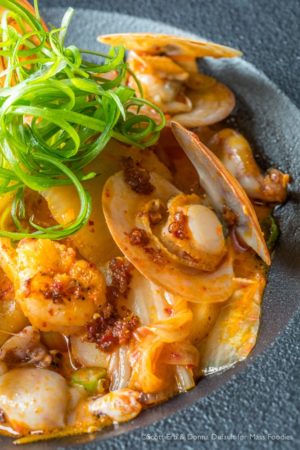
And oh the flavor. Raw they are just nuggets of pure sweet scallop joy. They may be expensive but worth every bite, most notably in the spicy seafood stew, which also features baby cuttlefish, Florida rock shrimp, and pieces of whatever fresh fish is around.
Simjang is more, of course, than its raw bar. That said, it would make Forman completely happy to just see people lined up at the deep rock maple bar having a Jang, oysters, Korean fried chicken, and heading happily off. But come back another time for the rest of the menu: “I love oysters, I love bold Korean flavors,” Forman says, “mixing them is what I think is great about this country and great about food.”

